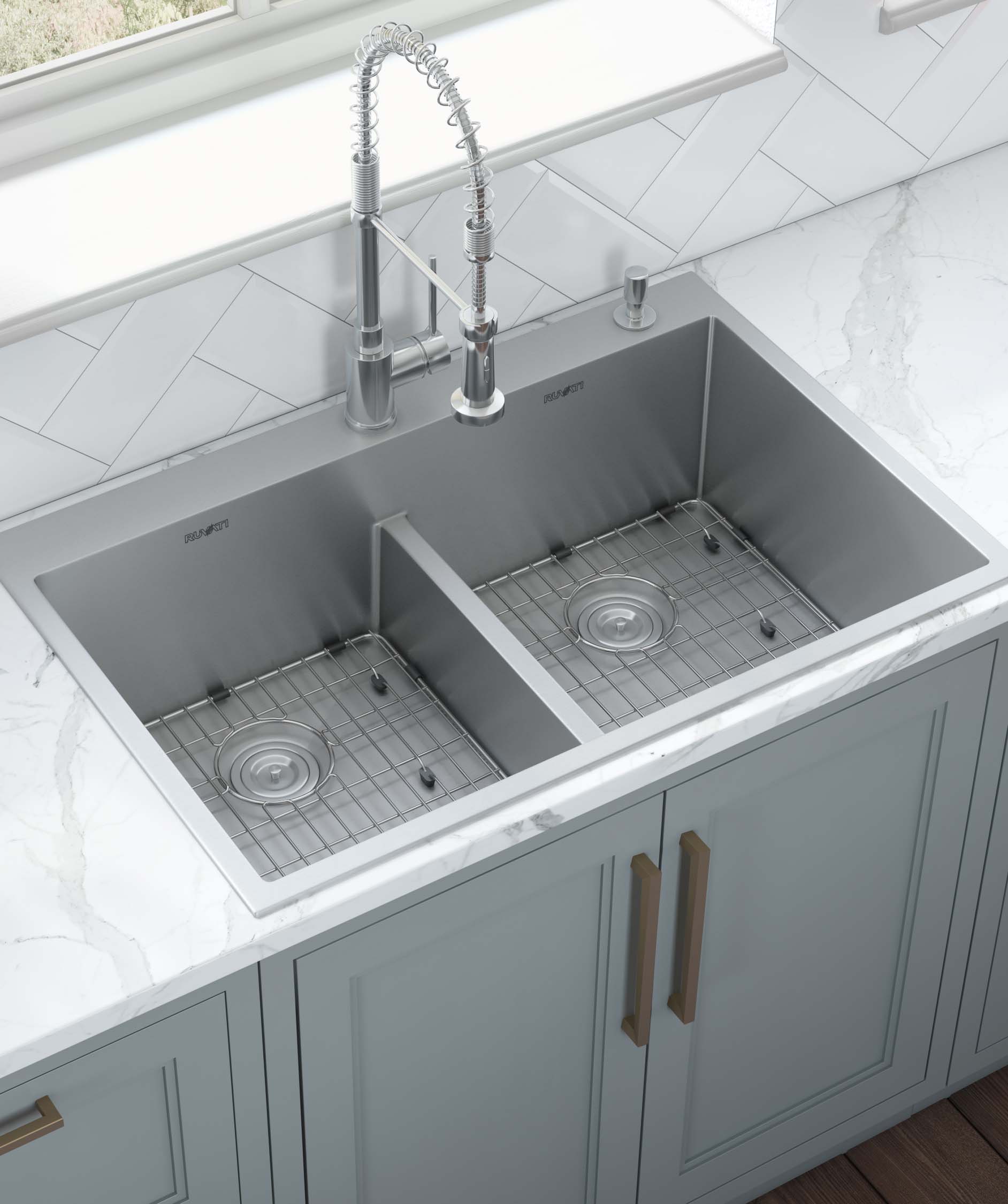With various materials and styles available, kitchen sinks come in 21 different types, each suited for specific needs and aesthetic preferences.
Kitchen Sink Styles Explored
When selecting a kitchen sink, many options are available, each offering its own unique design and functionality. Your style can significantly impact your kitchen’s overall aesthetics and practicality. This section will explore the various kitchen sink styles, discussing the importance of selecting the right one and the factors influencing sink selection.
Importance Of Choosing The Right Kitchen Sink
A kitchen sink is undeniably one of the most frequently used fixtures in any kitchen. Its importance cannot be overstated due to its daily role in meal preparation, cooking, and cleaning. Choosing the right kitchen sink can make your kitchen tasks more efficient, improve workflow, and enhance the overall functionality of your kitchen.
Moreover, the sink serves as a visual centerpiece of your kitchen, contributing to the overall style and ambiance of the space. It is essential to consider both form and function when selecting a sink, ensuring that it complements your kitchen’s design while meeting your practical needs.
Factors Influencing Sink Selection
Several key factors should be taken into account when choosing a kitchen sink. These considerations will help ensure that your sink selection aligns perfectly with your requirements and preferences.
- Size and configuration: Assess the available space in your kitchen and consider the size and configuration that will best suit your needs. You may opt for a single-bowl sink for compact kitchens or a double- or triple-bowl sink if you require more workspace.
- Material: The sink’s material determines its durability, maintenance requirements, and appearance. Different materials, such as stainless steel, granite composite, porcelain, and fireclay, offer varied characteristics and aesthetics.
- Style: From farmhouse sinks to under-mount sinks, your style will significantly impact your kitchen’s overall look and functionality. Consider the design theme and the practicality of different sink styles before deciding.
- Installation method: The installation method can influence the ease of maintenance and visual appeal. Standard installation options include drop-in (top-mount), under-mount, and apron-front sinks.
- Accessories and features: Sink accessories and features, such as built-in cutting boards, colanders, and drain boards, can significantly enhance the usability and convenience of your sink.
- Budget: Set a budget that suits your financial constraints, considering upfront costs and long-term maintenance expenses. Look for options that provide good value for your money without compromising quality.
By carefully considering these factors, you can make an informed decision when selecting a kitchen sink that meets your functional requirements, complements your kitchen’s design, and adds value to your everyday tasks.
Ultimate Guide To Sink Materials
Welcome to the ultimate guide to sink materials! The material you choose for your kitchen sink can significantly impact its durability and aesthetic appeal. This comprehensive guide will explore the pros and cons of various sink materials, including stainless steel, composite, cast iron, and fireclay sinks. Whether you’re remodeling your kitchen or simply looking for an upgrade, this guide will help you make an informed decision. Let’s dive in!
Stainless Steel: Pros And Cons
Stainless steel sinks are widely popular for their durability and timeless appeal. They’re resistant to stains, heat, and corrosion, making them an excellent choice for busy kitchens. They’re highly versatile and can complement various kitchen styles and color schemes.
- Highly durable and long-lasting.
- Easy to clean and maintain.
- Resistant to stains, heat, and corrosion.
- A variety of styles and sizes are available.
- Budget-friendly option.
- Prone to scratching, although higher-quality options are less susceptible.
- It may show water spots if not dried properly.
- It can produce more noise when dishes or utensils are dropped.
Composite Sinks: What To Know
Composite sinks are made from a combination of materials, typically granite or quartz particles, bound together by epoxy or acrylic resins. This creates a sink that offers exceptional durability and aesthetic versatility.
- Durable and resistant to scratches, chips, and stains.
- It is available in various colors, allowing you to find the perfect match for your kitchen decor.
- Composite sinks can be more expensive than other options, but their longevity makes them a worthwhile investment.
- Composite sinks are typically heavier than others, so proper installation is crucial.
Cast Iron Allure
Cast iron sinks have a classic, timeless appeal that can enhance the elegance of any kitchen. These sinks are made from solid iron and coated with enamel, providing a durable and smooth finish.
- Extremely durable and resistant to chipping and scratching.
- The enamel coating withstands high temperatures and protects against stains.
- Available in various colors and styles to match your kitchen design.
- Heavyweight, which requires proper support during installation.
- Cast iron sinks can be pricier than other options, but their longevity and aesthetic value make them famous.
Fireclay Sinks: Elegance and Durability
Fireclay sinks are crafted from a unique blend of clay and glaze. This combination results in a sink that combines the timeless elegance of porcelain with exceptional durability.
- Elegant, glossy finish that adds a touch of luxury to your kitchen.
- Resistant to staining, scratching, and fading.
- It is highly durable and can withstand heavy daily use.
- Available in different styles and sizes to complement any kitchen design.
- Fireclay sinks are typically more expensive than other options but offer long-lasting beauty and functionality.
Mounting Methods Unveiled
Choosing the perfect kitchen sink involves considering the material, style, and mounting method. The mounting method determines how your sink will be installed and affects your kitchen’s functionality and aesthetics. This article will explore kitchen sinks’ three main mounting methods: top-mount/drop-in sinks, under-mount sinks, and integrated sinks.
Top-mount/drop-in Sinks
As the name suggests, top-mount or drop-in sinks are installed by dropping the sink into a hole cut out in the countertop. It is then secured in place using clips or other hardware. These sinks have a rim or lip that rests on the countertop, creating a visible edge. This method is the most common and widely used option, offering easy installation and compatibility with various countertop materials.
Top-mount sinks have their advantages. The visible rim provides a stylish look that can instantly enhance the overall appearance of your kitchen. Additionally, the rim acts as a protective barrier, preventing water and spills from flowing onto the countertop. Maintaining and cleaning these sinks is a breeze, as you can easily wipe any debris straight into the sink without worrying about it getting stuck under the countertop.
However, it is essential to note that the rim can sometimes collect dirt and grime, making cleaning more challenging. This mounting method also reduces the usable space in the sink, as the rim takes up some of the sink’s capacity. Nonetheless, top-mount sinks remain popular due to their versatility and ease of installation.
Undermount Sinks: Sleek Finish
Undermount sinks offer a seamless and sleek finish, making them a popular choice for those seeking a modern look in their kitchen. Unlike top-mount sinks, under-mount sinks are installed beneath the countertop, creating a smooth and uninterrupted surface from the countertop edge to the sink basin.
The absence of a visible rim allows for easy cleaning and helps maintain a tidy and clutter-free countertop. With no rim to trap dirt and moisture, under-mount sinks offer exceptional hygiene and durability. They also provide more outstanding design and countertop material freedom, as the countertop can extend directly over the sink edge, giving it a more sophisticated and streamlined appearance.
However, the installation process of under-mount sinks is more complex than top-mount sinks. It requires the creation of a custom cut-out in the countertop, and the sink must be securely attached to the underside of the countertop using fasteners. Proper installation is crucial to prevent any damage or sagging of the sink over time.
Integrated Sinks: Seamless Design
Integrated sinks take the concept of under-mount sinks to the next level by seamlessly combining the countertop and sink into one continuous surface. No visible seams or joints with integrated sinks provide a truly sleek and modern design.
The seamless design of integrated sinks offers numerous benefits. They are effortless to clean, as there are no edges or crevices for dirt and bacteria to accumulate. The lack of seams also prevents water or liquids from seeping into the countertop, ensuring long-lasting durability.
The installation of integrated sinks requires advanced craftsmanship and expertise. It typically involves custom fabrication to integrate the sink directly into the countertop material, resulting in a cohesive and visually appealing finish.
The mounting method you choose for your kitchen sink is an important consideration that can significantly impact your kitchen’s overall functionality and aesthetics. Whether you opt for a top-mount or drop-in sink, an under-mount sink, or an integrated sink, each mounting method offers unique advantages and considerations. Consider your preferences, maintenance requirements, and the style you wish to achieve when selecting the perfect mounting method for your kitchen sink.
Tailoring Functionality With Basin Types
Tailoring functionality to basin types is crucial when considering 21 different kitchen sink styles and materials. Explore options from stainless steel to fireclay to suit your cooking needs and aesthetic preferences.
Single Vs. Double Basins
One of the first decisions you’ll need to make when choosing a kitchen sink is whether to go for a single or double basin. Both options offer unique advantages, and it’s essential to consider your cooking and cleaning habits.
Single basins are perfect for those needing extra space to clean more significant items like pots and pans. They provide a generous surface area, making maneuvering and cleaning up after cooking easier.
On the other hand, double basins offer versatility and convenience. They allow multitasking, with one basin dedicated to prepping and the other for soaking or washing. This can be especially helpful in a busy kitchen where multiple tasks happen simultaneously.
Farmhouse Style: A Rustic Approach
If you want to add a touch of rustic charm to your kitchen, a farmhouse-style sink is the way to go. These sinks are known for their large, deep basins and apron-front design, extending past the countertop’s edge.
Farmhouse sinks are not only aesthetically pleasing but also highly functional. Their spacious basins make it easy to handle large dishes and clean up after family gatherings or dinner parties. The apron-front design adds a timeless look that complements various kitchen styles.
Prep Sinks: Adding Convenience
Prep sinks are a game-changer when it comes to maximizing efficiency in the kitchen. These smaller, secondary sinks are typically installed in a separate kitchen area, often on an island or near the food preparation area.
With a prep sink, you can quickly rinse vegetables, wash your hands, or clean utensils without interrupting the main sink. This added convenience saves you time and effort, especially during meal prep or when multiple people work in the kitchen.
Design Considerations For Sink Selection
When it comes to choosing a kitchen sink, there are several design considerations that you need to keep in mind. From the size and layout of your kitchen to the depth of the sink and the type of faucet you choose, each decision will impact the functionality and aesthetics of your kitchen. To help you make an informed choice, let’s delve into the critical design considerations for sink selection.
Sink Size And Kitchen Layout
The size of your sink is crucial in determining its functionality in your kitchen. Before selecting, it’s essential to consider your kitchen layout and available space. Take measurements and consider factors such as the size of your countertops, the distance between appliances, and any existing plumbing connections.
If you have a smaller kitchen, you may opt for a compact sink that efficiently utilizes the available space. On the other hand, a larger kitchen may accommodate a more expansive sink for increased convenience.
Determining The Correct Depth
Choosing the proper depth for your kitchen sink ensures comfortable and efficient use. The depth of your sink will depend on your specific needs and preferences.
A deeper sink may be ideal for busy households with a lot of cooking and cleaning as it allows for easy handling of larger pots and pans. On the other hand, a shallower sink may be more suitable if you have a smaller kitchen or do not require heavy-duty usage.
Choosing The Right Faucet
The choice of faucet is just as crucial as the sink itself. A high-quality faucet not only enhances the overall aesthetics of your kitchen but also contributes to the sink’s functionality.
Consider the style and finish of the faucet that best complement your kitchen design. Consider the specific features you want, such as a pull-down sprayer or touchless operation. Matching the faucet to the sink size and layout ensures compatibility and ease of use.
Research and compare different faucet options to make an informed decision that meets your needs and preferences.
Considering these design considerations for sink selection, you can find the perfect kitchen sink that meets your functional and aesthetic requirements. Remember your kitchen layout, the desired sink depth, and the choice of faucet to create a harmonious and practical kitchen space.
21 Types Of Kitchen Sinks & Styles
The sink is vital for functionality and aesthetic appeal in a modern kitchen. Finding the perfect kitchen sink that suits your needs and complements your kitchen design can be daunting. With numerous types and styles of kitchen sinks available, it’s essential to understand the different materials and styles to make an informed decision. In this article, we will explore the 21 types of kitchen sinks and delve into their various materials and styles.
Overview Of Each Sink Type
Let’s start by providing a brief overview of each sink type:
1. Stainless Steel Sinks
Stainless steel sinks are durable, easy to maintain, and resistant to stains and heat.
2. Composite Granite Sinks
Composite granite sinks offer a natural stone-like appearance with exceptional durability.
3. Cast Iron Sinks
Cast iron sinks provide a traditional and timeless look but require regular maintenance to prevent chipping and staining.
continues the same way for the remaining 18 sink types
Detailed Comparison Based On Style And Utility
Now, let’s compare these sink types in terms of style and utility:
Style Comparison
add remaining rows
| Sink Type | Style |
|---|---|
| Stainless Steel Sinks | Modern and versatile |
| Composite Granite Sinks | Natural and contemporary |
| Cast Iron Sinks | Traditional and elegant |
Utility Comparison
-
- Stainless steel sinks are highly durable and resistant to rust, stains, and heat.
- Composite granite sinks are exceptionally durable, scratch-resistant, and heat-resistant.
- Cast iron sinks are classic and sturdy but require regular maintenance to prevent chipping and staining.
Add the remaining list items.
By understanding each sink type’s distinct features and characteristics, you can choose the one that suits your preferences and needs. Whether you prefer a modern stainless steel sink or a classic cast iron sink, a wide range of options are available to enhance the look and functionality of your kitchen.
Enhancements And Accessories
There’s more than just the central fixture to consider regarding kitchen sinks. Enhancements and accessories can make a significant difference in the functionality and aesthetics of your space. From sink grids and strainers to cutting boards and colanders, these accessories have the power to enhance your kitchen sink experience. Let’s look at some of the top enhancements and accessories you can add to your kitchen sink.
Sink Grids And Strainers
Sink grids and strainers are essential accessories that can help keep your kitchen sink clean and organized. Sink grids, typically made from stainless steel or rubber, fit perfectly into the bottom of your sink, providing a protective barrier against scratches and dings. They prevent dishes and utensils from directly contacting the sink’s surface, allowing water to flow freely and efficiently.
Filters, however, help trap food particles and prevent them from blocking your drain. Available in various sizes and materials, strainers effectively catch debris, making clean-up a breeze. With sink grids and strainers, you can enjoy a pristine, clutter-free sink that stays in top condition for years.
Cutting Boards And Colanders
Cutting boards and colanders are two practical kitchen sink accessories that can make meal preparation a breeze. Cutting boards, often designed to fit seamlessly over your sink, create an additional workspace for chopping, slicing, and dicing. They provide a stable surface and prevent messes by allowing food scraps to fall directly into the sink, making clean-up effortless.
Colanders, on the other hand, are ideal for washing fruits and vegetables and straining pasta. These handy accessories fit conveniently into the sink, allowing you to rinse and drain quickly and easily. With cutting boards and colanders, you can save valuable counter space and streamline your kitchen workflow, all while keeping your sink area tidy and efficient.
Soap Dispensers And Hot Water Taps
Regarding convenience, soap dispensers and hot water taps are two fantastic enhancements for your kitchen sink. Soap dispensers eliminate the need for unsightly soap bottles cluttering up your countertop. Instead, you can install a sleek and stylish dispenser in your sink area, ensuring that handwashing and dishwashing are a breeze.
On the other hand, hot water taps provide instant hot water at your fingertips, eliminating the wait time for boiling water on the stove. These taps are a game-changer for busy kitchens, making it quick and easy to prepare hot beverages, rinse dishes, and tackle tough grease and grime. With soap dispensers and hot water taps, you can elevate your kitchen sink’s functionality and style.

Frequently Asked Questions For 21 Types Of Kitchen Sinks: Different Materials And Styles
What Are The Advantages Of Stainless Steel Kitchen Sinks?
Stainless steel kitchen sinks are durable, resistant to stains and corrosion, easy to clean, and can withstand high temperatures. They also have a sleek, modern appearance and are hygienic, making them a popular choice among homeowners.
How Do Composite Kitchen Sinks Compare To Other Materials?
Composite kitchen sinks, made from a combination of materials like granite or quartz and resin, offer durability and resistance to stains and scratches and come in various colors. They are also less likely to chip or crack than porcelain or stainless steel materials.
Which Type Of Kitchen Sink Material Is The Most Cost-effective?
Acrylic kitchen sinks are generally the most cost-effective option. They are lightweight, easy to install, resistant to stains and scratches, and come in various colors. However, they may not be as durable or long-lasting as other materials.
Conclusion
To wrap up, choosing the right kitchen sink is essential for functionality and aesthetics. With the variety of materials and styles available, you can find one that perfectly suits your needs and enhances your kitchen space. Whether you prefer stainless steel for durability or apron-front sinks for a farmhouse feel, this guide has provided you with insights into 21 types of kitchen sinks.
When deciding, consider your budget, maintenance requirements, and overall design. Happy sink shopping!

Hi, I’m Esrat, and I’m so glad that you found me here at Happy Food Kitchen! I started Happy Food Kitchen in 2023 to have a creative, right-brained outlet to balance my very left-brained career in genetics.






